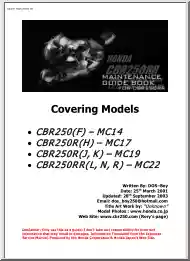Alapadatok
Év, oldalszám:2011, 2 oldal
Nyelv:angol
Letöltések száma:5
Feltöltve:2022. október 31.
Méret:5 MB
Intézmény:
-
Megjegyzés:
Csatolmány:-
Letöltés PDF-ben:Kérlek jelentkezz be!
Nincs még értékelés. Legyél Te az első!
Tartalmi kivonat
Tech Tips VW belt replacement JOBS guide Large numbers of the VW 2.0L common rail engines (engine code CBDB) are installed in various models. When the timing belt is changed, serious mistakes are often made To ensure that changing belts goes smoothly, ContiTech Power Transmission Group provides a step by step, detailed installation guide to help prevent problems along the way. These are detailed instructions for replacing the timing belt on the 2.0 litre common rail engine in the VW Scirocco, Golf V, Golf VI, Golf Plus and Jetta III. These timing belts are found from model year 2008 onwards, and are found on engines that bear the code CBDB. Volkswagen recommends that the timing belt and tension pulley be replaced as follows: Scirocco: 2009 and older: every 180,000 km 2010 on: timing belt, tension pulley every 210,000 km Golf Plus: Timing belt every 180,000 km Golf V: Timing belt every 180,000 km Golf VI: Timing belt and tension pulley every 210,000 km Jetta III: 2009 and older:
Timing belt every 180,000 km, tension roller every 360,000 km 2010 on: timing belt and tension pulley every 210,000 km Fig. 2 Fig. 1 The working time is 2.2 hours for all engines Tip: When the timing belt is changed, the tension pulley, the idler pulley and the water pump should be replaced, too. Fitters require the following special tools for belt changing: 1. Locking pin for camshaft (OE 3359) 2. Locking pin for high-pressure pump gear (OE 3359) 3. Arrester (OE T 10172, OE T 10172/4) 4. Lock ring tool for crankshaft (OE T 10050) 5. Cap wrench (OE T 10264) 6. Locking tool (OE T 10265) Fig. 3 Safety notes: Turn the engine in the direction of engine rotation ONLY on the crankshaft gear. The crankshaft sprocket and camshaft sprocket must never be rotated after the timing belt has been removed. Do not use camshaft locking tool(s) as an arrester when loosening or tightening the camshaft gear. When turning the camshaft, the crankshaft may not be positioned at top dead center (OT). The
timing belt may not come in contact with oil or cooling water. Fig. 4 AUTOBIZ TECH TIPS December 2011 Compendium >> originally published in Autobiz September 2011 Adjustment work on the timing belt may be carried out only when the engine is cold. Make a note of the radio code. Disconnect the batterys negative terminal. We recommend that, once the timing belt has been removed, it always be replaced and never reused. Tightening torques: Note: Self-locking nuts and bolts should always be replaced, even if not always specified by the manufacturer. According to VW, the following nuts and bolts are to be replaced: Bolt(s) on the camshaft gear (tightening torque central bolt: 100 Nm, gear level 1: 20 Nm, gear level 2: 90°) Bolt(s) on the high-pressure pump gear (level 1: 20 Nm, level 2: 90°) Nut(s) of the tension pulley (level 1: 20 Nm, level 2: 45°) Center timing belt guard (10 Nm) Lower timing belt guard (10 Nm) Bolt(s) on the vibration damper (level 1: 10 Nm, level 2: 90°)
Idler pulley (50 Nm and turn an additional 90°). Removal: Remove engine cover. Dismantle fuel filter. Disconnect plug on the coolant temperature sensor. Open clip(s). Remove the upper timing belt guard Remove front right wheel-house liner. Remove drive unit belt. Remove vibration damper. Remove the lower timing belt guard. Remove the center timing belt guard. Remove coolant pipe(s). Position the engine at top dead center cylinder 1. Note the marking(s) (Fig. 1, No 1 and Fig 2, Nos 2 and 3). The geared segment on the timing belt gear of the camshaft must be at the top (Fig. 1, No 1) Use lock ring tool for crankshaft (OE T 10050) (Fig. 2, No. 1) Markings of the crankshaft and the lock ring tool for crankshaft must align (Fig. 2, Nos 2 and 3) Lock ring tool for crankshaft: Pins must be positioned flush in the bore hole. Use locking pins on the high-pressure pump gear and on the camshaft (Fig. 3, No 1 and Fig 4, No 1). Loosen the bolts on the high-pressure pump gear (Fig. 3, No 2) Loosen
the bolts on the camshaft gear (Fig. 4, No 2) Use arrester. Loosen the nut of the tension pulley (Fig. 5, No 1 and Fig. 6, No 1) Using the hex key, turn the eccentric of the tension roller (Fig. 5, No 3 and Fig 6, No 2) counterclockwise, until the tension roller can be disconnected with the special tool (Fig. 5, No 2) Cap wrench (OE T 10264). Locking tool (OE T 10265) Using the hex key, turn the tension pulley clockwise (max. load stop, Fig 6, No 2) Tighten the nut of the tension pulley slightly (Fig. 5, No. 1 and Fig 6, No 1) Remove the timing belt from the idler pulley first and then from the gear wheels. Installation: Adjustment work on the timing belt may be carried out only when the engine is cold. Tension pulley: The nose of the base plate must be in the recess (Fig. 7, No 1) Check the top dead center marking and readjust as required. The tension pulley must be locked using the locking tool and fixed to the stop on the right (Fig. 6, No 2) Turn the camshaft gear clockwise to the
stop. Turn the injection pump gear clockwise to the stop. Position the timing belt onto the crankshaft, tension Fig. 5 pulley, camshaft gear, coolant pump, and highpressure pump, in that order. Loosen the nut of the tension pulley. Remove special tool (locking tool). Ensure that the tension roller is positioned correctly. Using the hex key, turn the tension pulley clockwise (in the direction of the arrow). The pointer of the tension pulley must be flush with the recess in the base plate (Fig. 8, No 1) The nut of the tension pulley may not turn while this is being done (Fig. 8, No 2) Tighten the nut of the tension pulley (Fig. 8, No 2) Hold the camshaft gear to maintain pretension counterclockwise (use the arrester). Tighten bolt(s) on the camshaft gear (Fig. 4, No 2) Tighten the bolt(s) on the high-pressure pump gear (Fig. 3, No 2) Fig. 6 Remove locking pins on the high-pressure pump gear and on the camshaft pulley (Fig. 3, No 1 and Fig. 4, No 1) Remove crankshaft lock ring tool (Fig.
2, No 1) Rotate the crankshaft twice in the direction of engine rotation. Position the crankshaft right before the TDC of the first cylinder (Fig. 6) Use lock ring tool for crankshaft (OE T 10050) (Fig. 6, No. 1) Turn crankshaft until the lock ring tool can be used. The pin on the crankshaft lock ring tool must be directly in front of the bore hole of the sealing flange (Fig. 6, No 1) Turn crankshaft until the lock ring tool can be used (Fig. 6) Check whether the camshaft can be locked with the Fig. 7 lock ring tool. The pointer of the tension pulley must be flush with the recess in the base plate. Tighten bolt(s) on the camshaft gear. Tighten bolt(s) on the injection pump gear. The rest of the installation procedure takes place as for the disassembly procedure, in the reverse order. Mount the drive unit belt. Decode the radio, program the volatile memory. Start the engine and check for proper function. Read error memory. Carry out a test drive. Document timing belt change. Fig. 8
AUTOBIZ TECH TIPS December 2011 Compendium >> originally published in Autobiz September 2011
Timing belt every 180,000 km, tension roller every 360,000 km 2010 on: timing belt and tension pulley every 210,000 km Fig. 2 Fig. 1 The working time is 2.2 hours for all engines Tip: When the timing belt is changed, the tension pulley, the idler pulley and the water pump should be replaced, too. Fitters require the following special tools for belt changing: 1. Locking pin for camshaft (OE 3359) 2. Locking pin for high-pressure pump gear (OE 3359) 3. Arrester (OE T 10172, OE T 10172/4) 4. Lock ring tool for crankshaft (OE T 10050) 5. Cap wrench (OE T 10264) 6. Locking tool (OE T 10265) Fig. 3 Safety notes: Turn the engine in the direction of engine rotation ONLY on the crankshaft gear. The crankshaft sprocket and camshaft sprocket must never be rotated after the timing belt has been removed. Do not use camshaft locking tool(s) as an arrester when loosening or tightening the camshaft gear. When turning the camshaft, the crankshaft may not be positioned at top dead center (OT). The
timing belt may not come in contact with oil or cooling water. Fig. 4 AUTOBIZ TECH TIPS December 2011 Compendium >> originally published in Autobiz September 2011 Adjustment work on the timing belt may be carried out only when the engine is cold. Make a note of the radio code. Disconnect the batterys negative terminal. We recommend that, once the timing belt has been removed, it always be replaced and never reused. Tightening torques: Note: Self-locking nuts and bolts should always be replaced, even if not always specified by the manufacturer. According to VW, the following nuts and bolts are to be replaced: Bolt(s) on the camshaft gear (tightening torque central bolt: 100 Nm, gear level 1: 20 Nm, gear level 2: 90°) Bolt(s) on the high-pressure pump gear (level 1: 20 Nm, level 2: 90°) Nut(s) of the tension pulley (level 1: 20 Nm, level 2: 45°) Center timing belt guard (10 Nm) Lower timing belt guard (10 Nm) Bolt(s) on the vibration damper (level 1: 10 Nm, level 2: 90°)
Idler pulley (50 Nm and turn an additional 90°). Removal: Remove engine cover. Dismantle fuel filter. Disconnect plug on the coolant temperature sensor. Open clip(s). Remove the upper timing belt guard Remove front right wheel-house liner. Remove drive unit belt. Remove vibration damper. Remove the lower timing belt guard. Remove the center timing belt guard. Remove coolant pipe(s). Position the engine at top dead center cylinder 1. Note the marking(s) (Fig. 1, No 1 and Fig 2, Nos 2 and 3). The geared segment on the timing belt gear of the camshaft must be at the top (Fig. 1, No 1) Use lock ring tool for crankshaft (OE T 10050) (Fig. 2, No. 1) Markings of the crankshaft and the lock ring tool for crankshaft must align (Fig. 2, Nos 2 and 3) Lock ring tool for crankshaft: Pins must be positioned flush in the bore hole. Use locking pins on the high-pressure pump gear and on the camshaft (Fig. 3, No 1 and Fig 4, No 1). Loosen the bolts on the high-pressure pump gear (Fig. 3, No 2) Loosen
the bolts on the camshaft gear (Fig. 4, No 2) Use arrester. Loosen the nut of the tension pulley (Fig. 5, No 1 and Fig. 6, No 1) Using the hex key, turn the eccentric of the tension roller (Fig. 5, No 3 and Fig 6, No 2) counterclockwise, until the tension roller can be disconnected with the special tool (Fig. 5, No 2) Cap wrench (OE T 10264). Locking tool (OE T 10265) Using the hex key, turn the tension pulley clockwise (max. load stop, Fig 6, No 2) Tighten the nut of the tension pulley slightly (Fig. 5, No. 1 and Fig 6, No 1) Remove the timing belt from the idler pulley first and then from the gear wheels. Installation: Adjustment work on the timing belt may be carried out only when the engine is cold. Tension pulley: The nose of the base plate must be in the recess (Fig. 7, No 1) Check the top dead center marking and readjust as required. The tension pulley must be locked using the locking tool and fixed to the stop on the right (Fig. 6, No 2) Turn the camshaft gear clockwise to the
stop. Turn the injection pump gear clockwise to the stop. Position the timing belt onto the crankshaft, tension Fig. 5 pulley, camshaft gear, coolant pump, and highpressure pump, in that order. Loosen the nut of the tension pulley. Remove special tool (locking tool). Ensure that the tension roller is positioned correctly. Using the hex key, turn the tension pulley clockwise (in the direction of the arrow). The pointer of the tension pulley must be flush with the recess in the base plate (Fig. 8, No 1) The nut of the tension pulley may not turn while this is being done (Fig. 8, No 2) Tighten the nut of the tension pulley (Fig. 8, No 2) Hold the camshaft gear to maintain pretension counterclockwise (use the arrester). Tighten bolt(s) on the camshaft gear (Fig. 4, No 2) Tighten the bolt(s) on the high-pressure pump gear (Fig. 3, No 2) Fig. 6 Remove locking pins on the high-pressure pump gear and on the camshaft pulley (Fig. 3, No 1 and Fig. 4, No 1) Remove crankshaft lock ring tool (Fig.
2, No 1) Rotate the crankshaft twice in the direction of engine rotation. Position the crankshaft right before the TDC of the first cylinder (Fig. 6) Use lock ring tool for crankshaft (OE T 10050) (Fig. 6, No. 1) Turn crankshaft until the lock ring tool can be used. The pin on the crankshaft lock ring tool must be directly in front of the bore hole of the sealing flange (Fig. 6, No 1) Turn crankshaft until the lock ring tool can be used (Fig. 6) Check whether the camshaft can be locked with the Fig. 7 lock ring tool. The pointer of the tension pulley must be flush with the recess in the base plate. Tighten bolt(s) on the camshaft gear. Tighten bolt(s) on the injection pump gear. The rest of the installation procedure takes place as for the disassembly procedure, in the reverse order. Mount the drive unit belt. Decode the radio, program the volatile memory. Start the engine and check for proper function. Read error memory. Carry out a test drive. Document timing belt change. Fig. 8
AUTOBIZ TECH TIPS December 2011 Compendium >> originally published in Autobiz September 2011



